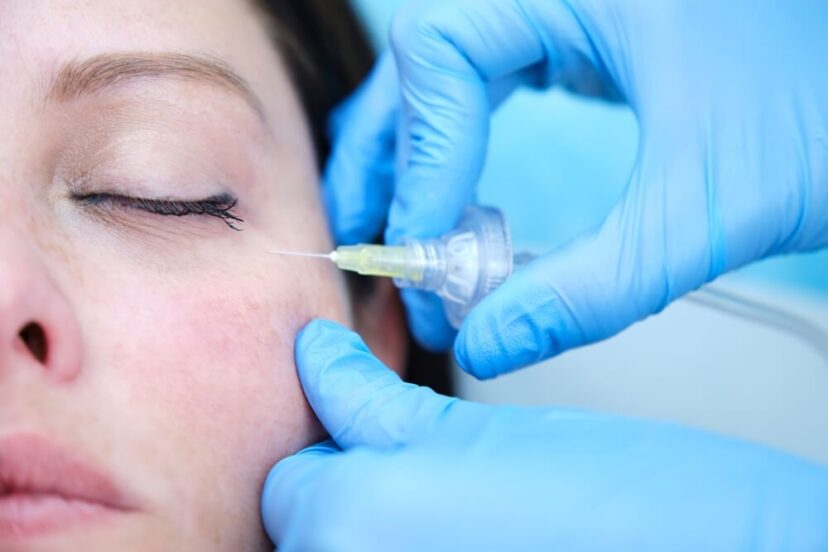Carboxytherapy: Amazing New Technology!
Carboxytherapy is a non-surgical cosmetic procedure that involves the administration of carbon dioxide (CO2) gas into the subcutaneous or dermal layers of the skin. This technique has gained popularity in the aesthetic and medical fields due to its diverse applications and effectiveness in treating a variety of conditions. Below, we delve into the science, merits, applications, and potential drawbacks of carboxytherapy, providing a comprehensive understanding of this innovative treatment.
LINK: The Use of Carboxytherapy & Your Deep Plane Facelift
The Science Behind Carboxytherapy
Carboxytherapy leverages the physiological responses to carbon dioxide to promote skin health and treat various conditions. When CO2 is injected into the skin, it diffuses into the surrounding tissues and blood vessels. This process leads to several key physiological effects:
- Vasodilation: CO2 induces the expansion of blood vessels, improving blood flow to the targeted area. This enhanced circulation brings more oxygen and nutrients to the skin and underlying tissues, promoting healing and rejuvenation.
- Bohr Effect: The presence of CO2 in tissues causes hemoglobin to release more oxygen, a phenomenon known as the Bohr effect. This increased oxygenation further supports tissue repair and regeneration.
- Stimulation of Collagen Production: The injection of CO2 stimulates fibroblasts, the cells responsible for producing collagen. Collagen is a crucial protein for maintaining skin elasticity and firmness, and its production decreases with age.
- Lipolysis: Carboxytherapy can also promote the breakdown of fat cells (lipolysis). CO2 diffuses into fat cells, causing them to rupture and be removed by the body’s natural processes.
Merits of Carboxytherapy
Carboxytherapy offers several advantages that make it an appealing option for both patients and practitioners:
- Minimally Invasive: As a non-surgical procedure, carboxytherapy involves minimal downtime and risk compared to more invasive treatments like liposuction or facelifts.
- Versatility: It can be used to treat a wide range of conditions, from aesthetic concerns like wrinkles and cellulite to medical issues such as chronic wounds and erectile dysfunction.
- Safety: When performed by a trained professional, carboxytherapy is generally safe with few side effects. Common side effects are temporary and may include minor bruising or discomfort at the injection site.
- Quick Procedure: Treatments are relatively quick, often lasting between 15 to 30 minutes, making it convenient for patients with busy schedules.
- Natural Process: The use of CO2, a naturally occurring gas in the body, reduces the likelihood of allergic reactions or complications associated with foreign substances.
Applications of Carboxytherapy
Carboxytherapy has a broad range of applications in both cosmetic and medical fields. Here, we explore some of the most common uses:
- Aesthetic Applications
- Anti-Aging and Wrinkle Reduction: One of the primary uses of carboxytherapy is to combat signs of aging. By stimulating collagen production and improving skin oxygenation, it helps reduce the appearance of fine lines and wrinkles, resulting in smoother, more youthful skin.
- Cellulite Reduction: Cellulite, characterized by dimpled skin, often affects the thighs, buttocks, and abdomen. Carboxytherapy improves blood flow and lymphatic drainage in these areas, reducing the appearance of cellulite and smoothing the skin’s texture.
- Stretch Mark Treatment: Stretch marks, caused by rapid stretching of the skin, can be challenging to treat. Carboxytherapy promotes collagen and elastin production, helping to repair and fade stretch marks over time.
- Dark Circles and Under-Eye Bags: Injecting CO2 into the delicate skin under the eyes can enhance circulation and improve skin elasticity, reducing dark circles and puffiness.
- Scarring: Whether from acne, surgery, or injury, scars can be distressing. Carboxytherapy helps break down scar tissue and stimulates healthy skin regeneration, improving the appearance of scars.
- Medical Applications
- Wound Healing: Chronic wounds, such as diabetic ulcers, can benefit from carboxytherapy. Improved blood flow and oxygenation facilitate faster and more effective healing of these stubborn wounds.
- Erectile Dysfunction: In some cases, carboxytherapy has been used to treat erectile dysfunction by enhancing blood flow to the penile tissues, thus improving erectile function.
- Hair Loss: By increasing blood circulation to the scalp and stimulating hair follicles, carboxytherapy can be an adjunct treatment for hair loss conditions like androgenetic alopecia.
- Psoriasis and Dermatitis: The anti-inflammatory effects of carboxytherapy can provide relief for patients suffering from skin conditions such as psoriasis and dermatitis.
- Pain Management: Some studies suggest that carboxytherapy can help manage pain conditions, including musculoskeletal pain and fibromyalgia, by improving tissue oxygenation and reducing inflammation.
Procedure and Techniques
The carboxytherapy procedure involves the following steps:
- Consultation: A thorough consultation is conducted to understand the patient’s concerns, medical history, and treatment goals. This helps in designing a personalized treatment plan.
- Preparation: The treatment area is cleaned and, if necessary, numbed with a topical anesthetic to minimize discomfort.
- Injection: CO2 gas is administered using a fine needle or a specialized device. The depth and amount of CO2 injected depend on the treatment area and the specific condition being addressed.
- Post-Treatment Care: After the procedure, patients may experience mild swelling or bruising, which typically resolves within a few days. They are usually advised to avoid strenuous activities for a short period.
Potential Drawbacks and Considerations
While carboxytherapy offers numerous benefits, it is essential to consider potential drawbacks and limitations:
- Temporary Results: The effects of carboxytherapy, especially for cosmetic applications, are not permanent. Maintenance sessions are often required to sustain results.
- Variable Outcomes: Results can vary based on individual factors such as age, skin type, and the specific condition being treated.
- Side Effects: Common side effects include bruising, swelling, and discomfort at the injection site. In rare cases, there may be more severe reactions, although these are uncommon.
- Not Suitable for Everyone: Carboxytherapy may not be appropriate for individuals with certain medical conditions, such as severe respiratory disorders or uncontrolled hypertension. A thorough medical evaluation is necessary to determine suitability.
- Cost: Depending on the area and frequency of treatment, the cost of carboxytherapy can add up. It’s essential for patients to consider their budget and the potential need for multiple sessions.
Clinical Evidence and Research
Research on carboxytherapy has shown promising results across various applications. Studies indicate significant improvements in skin elasticity, reduction of cellulite, and enhanced wound healing. However, more extensive, long-term studies are needed to fully understand the mechanisms and optimize treatment protocols.
For instance, a study published in the Journal of Cosmetic Dermatology demonstrated that carboxytherapy could significantly reduce cellulite and improve skin texture in the treated areas. Another study in the International Journal of Dermatology found that carboxytherapy was effective in reducing dark under-eye circles, with minimal side effects.
Conclusion
Carboxytherapy represents a versatile and minimally invasive treatment option with a broad range of applications in both aesthetic and medical fields. By leveraging the body’s natural responses to CO2, this procedure can effectively address concerns such as wrinkles, cellulite, stretch marks, and more severe medical conditions like chronic wounds and erectile dysfunction.
The merits of carboxytherapy include its safety, minimal downtime, and natural mechanism of action. However, patients must consider the need for maintenance treatments, the variability of results, and the potential side effects. As research continues to evolve, carboxytherapy is likely to become an even more refined and effective treatment option, benefiting a wider range of patients.
Ultimately, carboxytherapy offers a promising blend of science and aesthetic appeal, providing a natural and effective way to enhance appearance and treat various medical conditions. Whether seeking to rejuvenate the skin, reduce cellulite, or improve wound healing, this innovative procedure holds significant potential in the realm of modern medical and cosmetic treatments.




